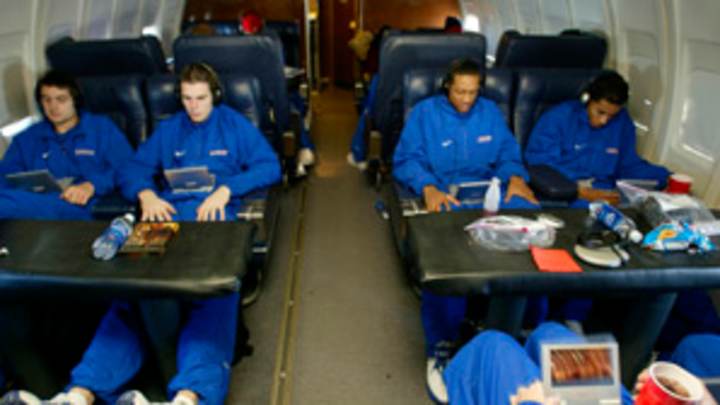Air travel is a necessary -- and rarely glamorous -- evil in sports


For most of human existence we've dreamed of flight, carving winged sphinxes onto Babylonian brickwork, imagining Icarus and all manner of flying machines -- many sketched by Leonardo da Vinci -- until somehow over the centuries these miracles came to be: The magnificent Montgolfier Brothers and their hot air balloon, the Wright Brothers, the Spirit of St. Louis, the Golden Age of Travel, Pan Am, TWA, the jet set and all the while Sinatra singing, "Come fly with me, we'll float down to Peru ..."
Today, of course, no one dreams of flight, a word drained of wonder by security wandings, underwear bombers, the drip torture of Boarding Groups One-Two-and-Three and that meek request of the economy-class peasant: "Please, sir, may I have the whole can?" -- squeaked out like Oliver Twist humbly requesting a second helping of gruel.
Which is why I've come to admire athletes less for their earthbound exploits than their extraterrestrial ones. Though it seldom calls traveling, the NBA requires pretty much constant travel, especially in a condensed season, when a typical week for the Lakers means playing a game in Los Angeles, then flying to Detroit, then flying to Washington, then flying to Minneapolis and then flying back to Los Angeles, conjuring images of Kobe Bryant as one of us: A middle-aged middle manager in a middle seat, longing for an upgrade to Economy Plus.
And while the Lakers travel in less austere conditions than you and I -- theirs is a first-class seat on a private 737; they always get to keep the whole can of Sprite -- they are bound to the same rules of aerodynamics. When the Lakers' plane landed in high wind in Detroit last season, and bounced back into the air before convulsively touching down again, there was little comfort in a lie-flat seat, at least metaphorically speaking.
Last month, when the Detroit Pistons' private MD-80 made an emergency landing at Hobby Airport in Houston, the experience was no less stressful simply because the rattling plates were china, and not the steaming sacks of carryout Kung Pao from Panda Express with which the rest of the flying public makes do.
The perception that air travel is glamorous disappeared for good when the Concorde did, in 2003, with one significant exception. The notion somehow persists that for professional athletes, travel is a movable feast of Champagne and shrimp cocktail, and slow-motion strolls through Miami International Airport flanked by Pan Am flight attendants circa 1967, a la that other flying Leonardo -- DiCaprio in Catch Me If You Can.
But I know better, having bused to the Edmonton airport with the New York Rangers after a night game, and sat in an empty terminal for ages while the team charter was tinkered with, and flown onward with them to Denver on a private flight every bit as depressing as a non-private one -- and perhaps more so, given that every passenger was male and not in full possession of his teeth (though in fairness this happens on many of my commercial flights, too).
And while the job of professional athlete has its compensations, staggering into an overly bright hotel lobby in Denver at 3 a.m. -- while the marble floor is burnished with an industrial buffer -- is not one of them.
Even so, for athletes this is the Golden Age of Air Travel, the best it's ever been. I'm old enough to have flown with the Cleveland Indians on a scheduled commercial flight from Toronto to Cleveland, big-league ballplayers on one side of the aisle, unwashed civilians on the other. It was not exactly a Ritz Carlton of the skies. Indeed, Indians' relief pitcher Jesse Orosco, sitting opposite me, spent the short flight spitting tobacco juice into an air sickness bag.
This is how most teams flew for most of their history -- on commercial flights, with the rest of us. And while teams are constantly on the go now, on private planes, they're not flying as much as they used to. Of current NBA teams, Miami flies the most miles on average (697 miles per game) and Cleveland the least (445 miles), according to Michael Wilczynski at weaksideawareness.com, who found that the late 1960s through the mid 1970s witnessed, in terms of sheer mileage flown, the peak of NBA teams traveling to and fro. (With an emphasis, in those years, on the fro.)
In the NHL this season, according to Dirk Hoag of ontheforecheck.com, the Kings will travel the most miles (55,591 total) and the Maple Leafs the fewest (32,239). And while baseball players spend the most days on the road, they aren't the most stalwart fliers: Seattle has flown the farthest on average over the last seven seasons (49,007 miles) and Milwaukee the shortest (25,431), according to research by Dave Allen at fangraphs.com.
If you concede that the most luxurious airplane seat is still less pleasant than the worst chair in your house, all these air miles are an athletic achievement. They belong on the back of one's baseball card: Miles Flown, Career.
When I turn on an NBA game now -- and the team I was watching in Boston last night magically appears on a court in Dallas -- all these flights are the first thing I think of. Sometimes they're the only thing I think of. "Air Jordan" always calls to my mind a Middle Eastern airliner. No wonder they built an arena for him and named it the United Center, and placed a statue of him out front, attempting to take flight.
